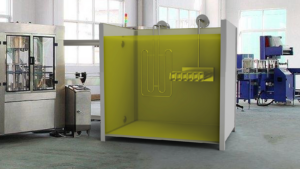How to Choose an Over-the-Side Heater for Your Industry
 Plant managers in many industries choose over-the-side (OTS) heaters when they need a budget-friendly and compact solution for industrial heating in tight spaces. Although these mobile heaters can suit numerous applications, industrialists still need to consider some factors to determine how an OTS heater will best serve them. This post will examine some purchase considerations for OTS heaters and the options available to those considering them.
Plant managers in many industries choose over-the-side (OTS) heaters when they need a budget-friendly and compact solution for industrial heating in tight spaces. Although these mobile heaters can suit numerous applications, industrialists still need to consider some factors to determine how an OTS heater will best serve them. This post will examine some purchase considerations for OTS heaters and the options available to those considering them.
Configuration of the OTS heater
A significant advantage of over-the-side heaters is their mobility. They’re ideal for industrial applications where space is limited, and the ability to place OTS heaters above or elsewhere on a tank alleviates space-related problems.
However, it’s crucial to orient and position an over-the-side heater in the most suitable location. It might be ideal to place the heater to extend to the bottom of the tank or only midway. That largely depends on the target liquid (and application).
The heater’s shape
The mobility of over-the-side heaters allows manufacturers to build them in various shapes. These shapes can affect the speed and intensity of the heat generated from the heater.
Typical shapes of over-the-side heaters
- O-shaped heaters
- L-shaped heaters
- Vertical loop heaters that consist of loops and that hang top-to-bottom
- Tube heaters that are cylindrical and consist of just tubular element
The ideal shape for over-the-side heaters will depend on the type of industrial application at hand. Here at Wattco, one of our most common offerings is a vertical loop OTS heater that can be submerged deep into a tank.
Sheath materials used in the OTS heater
Just as over-the-side heaters vary in shape, they can differ in terms of the sheath materials they use for heating. That is a crucial consideration for two reasons:
- Particular sheath materials are more efficient at heating target fluids.
- Some sheath materials are more (or less) resistant to elements such as corrosion and degradation.
That’s why it’s important for your over-the-side heater to use sheath materials that can efficiently heat your target substance without breaking down prematurely. Over the side heaters use a wide range of metals (but sometimes, rubber, semiconductors or ceramics) as sheath materials. Metals are the most common.
Typical over-the-side heater sheath materials
- Aluminum
- Brass
- Copper
- Iron
- Nickel alloy
- Stainless steel
- Steel
Choosing the right sheath material boils down to your target substance and factors such as cost-efficiency and minimizing wear and tear.
Industrial application for over the side heaters
When deciding the specifications and configurations of your OTS heater, the nature of your industrial application is the most crucial factor to consider. Your target compound by itself is a significant consideration because different fluids have their unique thermal properties.
Oils, acids, and other fluids will naturally react differently when subjected to certain temperatures, and your heater needs to have the capacity to bring them to your required state. That could mean the difference between a suitable or unviable product. Some other factors come into play, such as the shape and orientation of the heater.
Another consideration is practicality. Although over-the-side heaters can heat various liquids, they’re more suitable for certain applications. These are liquid, gas, or vapour heating in facilities where space might be limited.
Common uses for over the side heaters
- Light and heavyweight oils
- Degreasing solutions
- Caustic solutions
- Process waters
- High purity waters
Over-the-side heaters may or may not be used in conjunction with other processes that involve high-pressure systems or circulation heating (which usually happens separately).
Performance requirements
The thermal properties of your target substance and your production quotas will influence the performance requirements of your OTS heater. The main performance factors focus on heating efficiency.
Performance factors for over-the-side heaters
- Watt density: The measure of how quickly the over-the-side unit can transfer heat to a target surface.
- Maximum operating sheath: The highest temperature the heating element (and its sheath) can safely reach.
- Heating capacity: The overall wattage (which includes watt density) the heater can provide.
- Insertion length: The depth at which the heater can reach within a tank (which influences heating efficiency).
In addition to these four factors, it’s essential to consider some other aspects, such as the voltage required to power the heater and whether you need phase power (or not).
Choosing the best OTS heater for your industry
Over-the-side heaters are available in pre-constructed forms, especially for industrial applications with well-established performance requirements. However, you may need a custom solution to help optimize your heater’s performance.
Here at Wattco, we offer pre-constructed and custom over the side heaters to match the needs of your application. Our team of scientists and engineers will work to understand your business objectives and offer insights on the best configurations to help you reach those objectives.
Get a quote for your over te side heater today. Our representatives will help you find the exact setup needed for your industrial needs.
